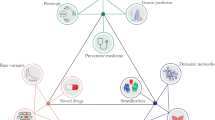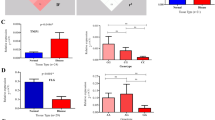Abstract
Tumor necrosis factor alpha-inducible protein 3 (TNFAIP3) encodes a ubiquitin-modifying protein, A20, that is a critical regulator of inflammatory responses. TNFAIP3 polymorphisms are associated with the susceptibility to multiple autoimmune diseases (AIDs) including psoriasis, systemic lupus erythematosus, rheumatoid arthritis, systemic sclerosis and celiac disease. In order to refine the TNFAIP3 association signal in psoriasis and identify candidate causal variants, we performed imputation and meta-analysis of the TNFAIP3 region in five European ancestry cohorts totaling 4704 psoriasis cases and 7805 controls. We identified 49 variants whose significance exceeded a corrected Bonferroni threshold, with the top variant being rs582757 (P=6.07 × 10−12, odds ratio (OR)=1.23). Conditional analysis revealed a suggestive independent association at rs6918329 (Pcond=7.22 × 10−5, OR=1.15). Functional annotation of the top variants identified several with a strong evidence of regulatory potential and several within long noncoding RNAs. Analysis of TNFAIP3 haplotypes revealed that the psoriasis risk haplotype is distinct from other AIDs. Overall, our findings identify novel candidate causal variants of TNFAIP3 in psoriasis and highlight the complex genetic architecture of this locus in autoimmune susceptibility.
This is a preview of subscription content, access via your institution
Access options
Subscribe to this journal
Receive 6 digital issues and online access to articles
$119.00 per year
only $19.83 per issue
Buy this article
- Purchase on Springer Link
- Instant access to full article PDF
Prices may be subject to local taxes which are calculated during checkout


Similar content being viewed by others
References
Parisi R, Symmons DP, Griffiths CE, Ashcroft DM et al Identification and Management of Psoriasis and Associated ComorbidiTy (IMPACT) project team. Global epidemiology of psoriasis: a systematic review of incidence and prevalence. J Invest Dermatol 2013; 133: 377–385.
Prieto-Perez R, Cabaleiro T, Dauden E, Ochoa D, Roman M, Abad-Santos F . Genetics of psoriasis and pharmacogenetics of biological drugs. Autoimmune Dis 2013; 2013: 613086.
Ellinghaus D, Ellinghaus E, Nair RP, Stuart PE, Esko T, Metspalu A et al. Combined analysis of genome-wide association studies for Crohn disease and psoriasis identifies seven shared susceptibility loci. Am J Hum Genet 2012; 90: 636–647.
Adrianto I, Wen F, Templeton A, Wiley G, King JB, Lessard CJ et al. Association of a functional variant downstream of TNFAIP3 with systemic lupus erythematosus. Nat Genet 2011; 43: 253–258.
Musone SL, Taylor KE, Lu TT, Nititham J, Ferreira RC, Ortmann W et al. Multiple polymorphisms in the TNFAIP3 region are independently associated with systemic lupus erythematosus. Nat Genet 2008; 40: 1062–1064.
Plenge RM, Cotsapas C, Davies L, Price AL, de Bakker PI, Maller J et al. Two independent alleles at 6q23 associated with risk of rheumatoid arthritis. Nat Genet 2007; 39: 1477–1482.
Koumakis E, Giraud M, Dieude P, Cohignac V, Cuomo G, Airo P et al. Brief report: candidate gene study in systemic sclerosis identifies a rare and functional variant of the TNFAIP3 locus as a risk factor for polyautoimmunity. Arthritis Rheum 2012; 64: 2746–2752.
Trynka G, Hunt KA, Bockett NA, Romanos J, Mistry V, Szperl A et al. Dense genotyping identifies and localizes multiple common and rare variant association signals in celiac disease. Nat Genet 2011; 43: 1193–1201.
Ma A, Malynn BA . A20: linking a complex regulator of ubiquitylation to immunity and human disease. Nat Rev Immunol 2012; 12: 774–785.
Lee EG, Boone DL, Chai S, Libby SL, Chien M, Lodolce JP et al. Failure to regulate TNF-induced NF-kappaB and cell death responses in A20-deficient mice. Science 2000; 289: 2350–2354.
Nair RP, Duffin KC, Helms C, Ding J, Stuart PE, Goldgar D et al. Genome-wide scan reveals association of psoriasis with IL-23 and NF-kappaB pathways. Nat Genet 2009; 41: 199–204.
Wang Z, Jacobs KB, Yeager M, Hutchinson A, Sampson J, Chatterjee N et al. Improved imputation of common and uncommon SNPs with a new reference set. Nat Genet 2012; 44: 6–7.
Genetic Analysis of Psoriasis Consortium & the Wellcome Trust Case Control Consortium, Strange A, Capon F, Spencer CC, Knight J et al. A genome-wide association study identifies new psoriasis susceptibility loci and an interaction between HLA-C and ERAP1. Nat Genet 2010; 42: 985–990.
DerSimonian R, Laird N . Meta-analysis in clinical trials. Controll Clin Trials 1986; 7: 177–188.
Boyle AP, Hong EL, Hariharan M, Cheng Y, Schaub MA, Kasowski M et al. Annotation of functional variation in personal genomes using RegulomeDB. Genome Res 2012; 22: 1790–1797.
Kircher M, Witten DM, Jain P, O'Roak BJ, Cooper GM, Shendure J . A general framework for estimating the relative pathogenicity of human genetic variants. Nature Genet 2014; 46: 310–315.
Hangauer MJ, Vaughn IW, McManus MT . Pervasive transcription of the human genome produces thousands of previously unidentified long intergenic noncoding RNAs. PLoS Genet 2013; 9: e1003569.
Wan Y, Qu K, Zhang QC, Flynn RA, Manor O, Ouyang Z et al. Landscape and variation of RNA secondary structure across the human transcriptome. Nature 2014; 505: 706–709.
Consortium EP, Birney E, Stamatoyannopoulos JA, Dutta A, Guigo R, Gingeras TR et al. Identification and analysis of functional elements in 1% of the human genome by the ENCODE pilot project. Nature 2007; 447: 799–816.
Verzi MP, Shin H, He HH, Sulahian R, Meyer CA, Montgomery RK et al. Differentiation-specific histone modifications reveal dynamic chromatin interactions and partners for the intestinal transcription factor CDX2. Dev Cell 2010; 19: 713–726.
Tsoi LC, Spain SL, Knight J, Ellinghaus E, Stuart PE, Capon F et al. Identification of 15 new psoriasis susceptibility loci highlights the role of innate immunity. Nat Genet 2012; 44: 1341–1348.
Tavares RM, Turer EE, Liu CL, Advincula R, Scapini P, Rhee L et al. The ubiquitin modifying enzyme A20 restricts B cell survival and prevents autoimmunity. Immunity 2010; 33: 181–191.
Chu Y, Vahl JC, Kumar D, Heger K, Bertossi A, Wojtowicz E et al. B cells lacking the tumor suppressor TNFAIP3/A20 display impaired differentiation and hyperactivation and cause inflammation and autoimmunity in aged mice. Blood 2011; 117: 2227–2236.
Kool M, van Loo G, Waelput W, De Prijck S, Muskens F, Sze M et al. The ubiquitin-editing protein A20 prevents dendritic cell activation, recognition of apoptotic cells, and systemic autoimmunity. Immunity 2011; 35: 82–96.
Hammer GE, Turer EE, Taylor KE, Fang CJ, Advincula R, Oshima S et al. Expression of A20 by dendritic cells preserves immune homeostasis and prevents colitis and spondyloarthritis. Nat Immunol 2011; 12: 1184–1193.
Vereecke L, Sze M, Mc Guire C, Rogiers B, Chu Y, Schmidt-Supprian M et al. Enterocyte-specific A20 deficiency sensitizes to tumor necrosis factor-induced toxicity and experimental colitis. J Exp Med 2010; 207: 1513–1523.
Matmati M, Jacques P, Maelfait J, Verheugen E, Kool M, Sze M et al. A20 (TNFAIP3) deficiency in myeloid cells triggers erosive polyarthritis resembling rheumatoid arthritis. Nat Genet 2011; 43: 908–912.
Lippens S, Lefebvre S, Gilbert B, Sze M, Devos M, Verhelst K et al. Keratinocyte-specific ablation of the NF-kappaB regulatory protein A20 (TNFAIP3) reveals a role in the control of epidermal homeostasis. Cell Death Differ 2011; 18: 1845–1853.
Liu Y, Helms C, Liao W, Zaba LC, Duan S, Gardner J et al. A genome-wide association study of psoriasis and psoriatic arthritis identifies new disease loci. PLoS Genet 2008; 4: e1000041.
Price AL, Patterson NJ, Plenge RM, Weinblatt ME, Shadick NA, Reich D . Principal components analysis corrects for stratification in genome-wide association studies. Nature genetics 2006; 38: 904–909.
Genomes Project Consortium, Abecasis GR, Altshuler D, Auton A, Brooks LD, Durbin RM et al. A map of human genome variation from population-scale sequencing. Nature 2010; 467: 1061–1073.
Marchini J, Howie B, Myers S, McVean G, Donnelly P . A new multipoint method for genome-wide association studies by imputation of genotypes. Nat Genet 2007; 39: 906–913.
Purcell S, Neale B, Todd-Brown K, Thomas L, Ferreira MA, Bender D et al. PLINK: a tool set for whole-genome association and population-based linkage analyses. Am J Hum Genet 2007; 81: 559–575.
Barrett JC, Fry B, Maller J, Daly MJ . Haploview: analysis and visualization of LD and haplotype maps. Bioinformatics 2005; 21: 263–265.
Nyholt DR . A simple correction for multiple testing for single-nucleotide polymorphisms in linkage disequilibrium with each other. Am J Hum Genet 2004; 74: 765–769.
Acknowledgements
This work was supported in part by grants from the National Institutes of Health (R01AR065174 and K08AR057763 to WL and 2R01 AR050266 to AB), Swedish Medical Research Council, Stockholm County Council, Swedish Psoriasis Association and the Agency for Science Technology and Research (ASTAR), Singapore. Funding for the Collaborative Association Study of Psoriasis was provided by the National Institutes of Health, the Foundation for the National Institutes of Health and the National Psoriasis Foundation. Support for genotyping of samples was provided through the Genetic Association Information Network (GAIN). Funding for WTCCC data was provided by the Wellcome Trust under awards 076113 and 085475.
Author information
Authors and Affiliations
Corresponding author
Ethics declarations
Competing interests
The authors declare no conflict of interest.
Additional information
Supplementary Information accompanies this paper on Genes and Immunity website
Supplementary information
Rights and permissions
About this article
Cite this article
Nititham, J., Taylor, K., Gupta, R. et al. Meta-analysis of the TNFAIP3 region in psoriasis reveals a risk haplotype that is distinct from other autoimmune diseases. Genes Immun 16, 120–126 (2015). https://doi.org/10.1038/gene.2014.75
Received:
Revised:
Accepted:
Published:
Issue Date:
DOI: https://doi.org/10.1038/gene.2014.75
This article is cited by
-
CRISPR/cas9 mediated knockout of an intergenic variant rs6927172 identified IL-20RA as a new risk gene for multiple autoimmune diseases
Genes & Immunity (2019)
-
Exploring the genetic basis of human population differences in DNA methylation and their causal impact on immune gene regulation
Genome Biology (2018)
-
Loss-of-function mutations in TNFAIP3 leading to A20 haploinsufficiency cause an early-onset autoinflammatory disease
Nature Genetics (2016)
-
Characteristics of A20 gene polymorphisms and clinical significance in patients with rheumatoid arthritis
Journal of Translational Medicine (2015)



